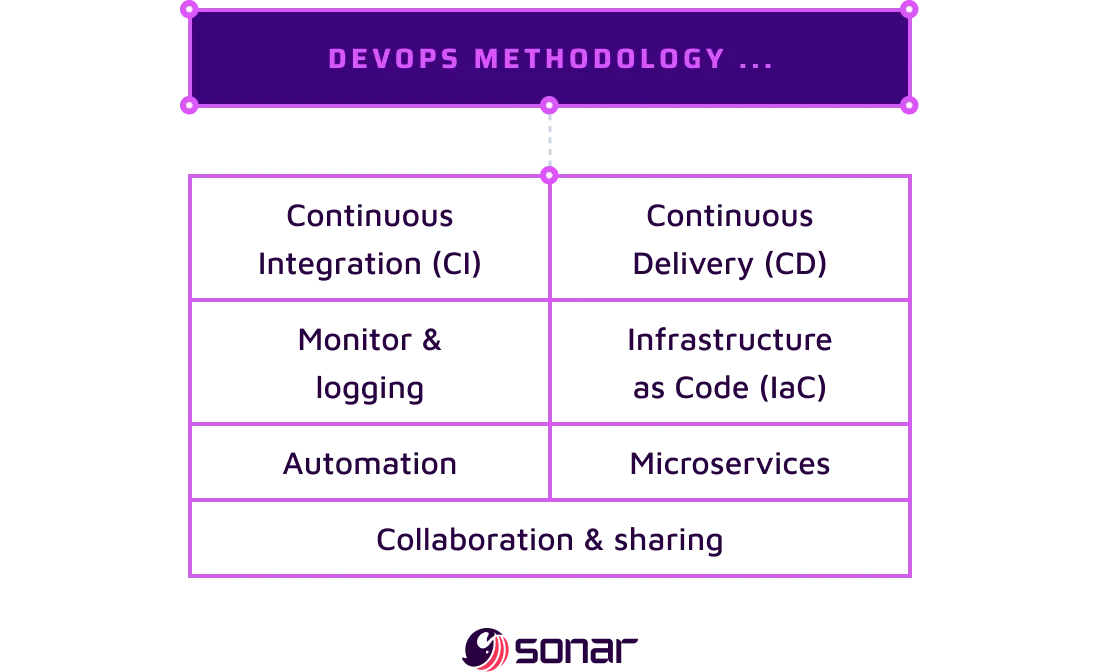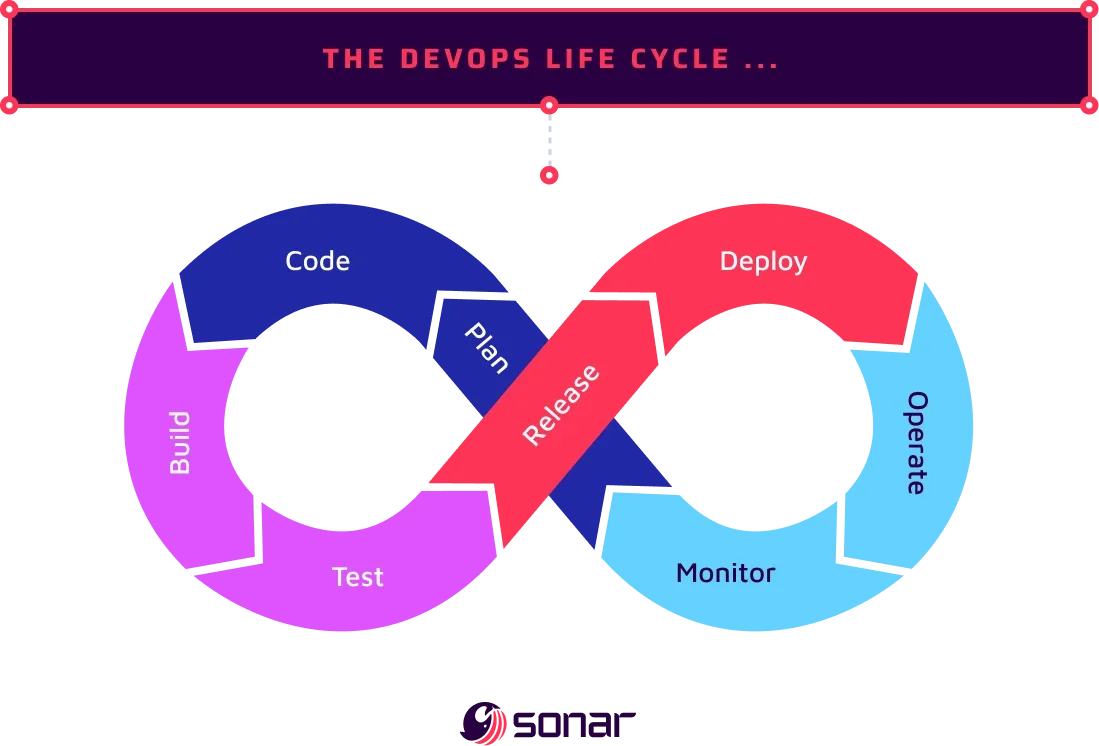What is DevOps?
DevOps is a combination of established practices and tools that combines software development (Dev) and IT operations (Ops) teams to more easily collaborate, integrate, automate and communicate during the software development life cycle (SDLC) while providing continuous delivery of high-quality software. The phrase “DevOps” is a combination of the words “development” and “operations.”
The purpose of DevOps is to remove the barriers and hindrances between legacy, or traditional, siloed teams of developers and IT operations staff. This is accomplished by nurturing a culture of collaboration and communication among these teams.
DevOps concentrates on collaboration, communication, integration, automation, and the common responsibility for the product or project's success.
DevOps is considered more of a cultural mindset than a stringent set of processes or rules; that allows a culture of collaboration to have a shared goal while delivering better software and services at higher developer velocity and deeper code quality.
In fact, DevOps encompasses a variety of components from principles and practices to technologies and tools, including:
Principles:
- Collaboration
- Automation
- Communal responsibility
Practices:
- Continuous integration/continuous delivery (CI/CD)
- Monitoring
- Logging
Technologies:
- Containers and Microservices
- Infrastructure as code (IaC)
Why DevOps?
DevOps offers a number of unique benefits to organizations from a technical, business, financial, and cultural perspective. DevOps is a strategic focus that utilizes technology and organizational culture to increase speed, quality, reliability, security, and other vital metrics connected to software development, delivery, and operations.
DevOps is not a tool or product but a shift from a culture that includes collaboration, communication integration, and automation for the final goal of pushing out better products efficiently.
What are the benefits of DevOps?
There are several benefits of DevOps from a technical, business, and cultural viewpoint to improve performance as a whole. Adopting DevOps can usher in a monumental transformation in the way organizations develop and deliver software. This can contribute to increased performance, much faster software delivery, better code quality, security and reliability, financial cost savings, and happier teams, developers, and work culture.

DevOps can provide:
What are the technical benefits of DevOps?
Quicker development and deployment
CI/CD pipelines are integral to DevOps, enabling the automated build, testing, and deployment of code changes to production environments as soon as they are ready.
Meaning, that features can be added quickly and easily, bugs, issues, or other problems may be detected efficiently in the software development process and the end product can be delivered to the customers in an appropriate amount of time.
Improved code quality and reliability
By integrating development and operations together, developers and teams are able to detect bugs much earlier in the development life cycle process.
Using best practices such as automated code review and testing allows the improvement of your overall code quality and reliability of software.
Reduced risk
By automating and standardizing the DevOps process you may reduce the risk of errors to your product.
By executing Infrastructure as Code (IaC), organizations are able to make the systems reproducible and thus easier to be resilient and recover from potential issues or roadblocks.
Enhanced performance
The constant communication and collaboration cultivate continual feedback and monitoring so systems are able to be optimized to enhance performance.
What are the business benefits of DevOps?
Quicker time to market
Businesses can push their product or new features to the market quickly by accelerating the software delivery process.
Improved customer experience satisfaction
Organizations can respond to client requests, suggestions, and needs more quickly by releasing software faster, improving customer satisfaction.
Cost-effective
Implementing DevOps practices such as effective resource management combined with virtualization or containerization technologies can aid business savings to the organization.
Increasing innovation
Utilizing the DevOps model allows teams to manage their workload more effectively, thus opening up additional resources and time to concentrate on innovating products.
What are the cultural benefits of DevOps?
Improved collaboration and communication
DevOps promotes a culture of cooperation and shared accountability.
Teams collaborate, share numerous responsibilities, and consolidate workflows together to reduce inefficiencies and waste time.
Employee engagement
Teams that operate in a DevOps culture frequently experience a greater sense of ownership over their work and a stronger sense of connection to the final product, which increases employee engagement and job satisfaction.
Skill development
DevOps emphasizes a culture of learning and continual improvement, facilitating team members in picking up new skills and information.
What are DevOps principles?
A few key principles serve as the basis of the DevOps philosophy.
These guiding principles provide insight into the main DevOps values and serve as a framework for putting DevOps techniques into practice.
Collaborative culture
Promoting a collaborative workplace culture where the development and operations teams collaborate as a single unit is one of the core ideas of DevOps.
This dismantles silos, enhances comprehension, and leads to a quicker and more dependable supply of software.
End-to-End responsibility
The DevOps team is fully responsible for all aspects of their services, from conception to disposal.
Everyone on the staff is encouraged to work responsibly, which results in higher-quality goods and an improved customer experience.
Continuous improvement
The culture of DevOps is focused on continuous learning and steady improvement.
Teams are constantly looking for methods to strengthen the system, learning from past mistakes, and continuously improving its performance.
Automation (in everything)
A foundational tenet of DevOps is automation.
Automation covers everything, including monitoring and reporting as well as continuous integration, testing, and deployment.
A quicker and more dependable process for delivering software is made possible through automation, which increases speed, decreases errors, and ensures consistency.
Prioritize customer needs
DevOps teams place a high priority on customer needs.
The ultimate objective is to increase customer happiness and deliver value to the consumer, whether it means creating new features, addressing issues, or optimizing system performance.
Test and monitor everything
Automated testing and system performance monitoring are essential components of DevOps.
Testing confirms that the software satisfies the necessary quality standards while monitoring assists in proactively discovering any irregularities or potential problems.
Together, they contribute to preserving a high standard of software reliability and quality.
Working in small batches
Work is separated into manageable, short batches in order to facilitate quicker issue detection and resolution.
Faster feedback and more regular deployments are made possible as a result, increasing production and efficiency.
What is a DevOps methodology?
DevOps methodologies are a collection of procedures and strategies that enable businesses to produce higher-quality, reliable software quickly. These approaches are made to encourage communication between the development and operations teams, automate routine tasks, and support continuous delivery and improvement.
The DevOps methodology may differ between organizations, teams, and purposes but typically include:

Continuous Integration (CI)
This is a technique where developers frequently merge their code changes into a main repository.
Automated builds and tests are executed following the addition of modifications.
The objective is to decrease the time needed to validate and deploy new software updates, enhance software quality, and promptly identify and fix defects.
Continuous Delivery (CD)
This is a perpetuation of continuous integration.
After the build step, it then automatically deploys all code alterations to a testing and/or production environment.
By using this procedure, you can have a deployable build artifact that is prepared to go live at any time, enabling a steady stream of improvements for consumers.
Monitor and logging
This entails keeping track of and logging system activity in order to assess the health of the system, identify issues, and resolve them.
Effective user behavior, performance of the system, and potential error insights can all be gained by effective monitoring and logging.
Automation
Automation applies to many phases of the software delivery lifecycle, including infrastructure setup, integration, testing, and deployment.
Automation speeds up the software delivery process, minimizes the possibility of human error, and helps remove manual, repetitive operations.
Microservices
This is a type of architectural design in which a single application is divided into a number of smaller services, each of which operates independently and interacts with the others via a well-defined interface.
Teams can deploy, scale, upgrade, and debug services independently using this method, which can speed up these procedures and lower the possibility of broad system failures.
Infrastructure as Code (IaC)
IaC in DevOps is the practice where infrastructure is organized and controlled by code and software development methods such as version control and continuous integration.
This enables the management of infrastructure by developers and operations teams in manners comparable to that of application code.
IaC can greatly increase the process of setting up and updating infrastructure consistently and repeatably.
Collaboration and sharing
DevOps promotes a collaborative environment in which developers and operations professionals cooperate throughout the application lifecycle.
Sharing responsibility, criticism, and understanding can result in greater comprehension, quicker problem-solving, and increased productivity.
DevOps methodologies are not siloed but rather are interwoven practices and strategies.
Applying DevOps to an organization’s needs is more than just adhering to these standards.
Implementing DevOps methodologies necessitates a cultural shift toward cooperation, transparency, and shared responsibility which could also call for more adjustments to roles, expectations, competencies, resources, and business structure.
What is the DevOps lifecycle?
The DevOps lifecycle is a continuous workflow that involves the constant interaction of a variety of stages. These stages are designed to create better collaboration between development, operations, and quality assurance teams in order to accelerate the delivery of software products, ensure their quality, and enhance customer satisfaction.

The DevOps lifecycle includes:
Planning
At this stage; teams define the system requirements, create a project plan, and recognize the needs and expectations. The purpose of this stage is to guarantee that all stakeholders have a firm grasp of the requirements and objectives of the project.
Coding
At this point, programmers begin writing the application's code. The standards and needs established during the planning stage serve as the basis for the coding. Version control systems are used by developers to maintain track of multiple code versions as well as a variety of coding tools.
Building
When the code is finished, it is constructed or compiled into an executable form that can be used to run on a computer. This process is automated using automated build tools, which can improve effectiveness and lower error rates.
Testing
At this stage, the software will be tested after it has been developed to identify any faults or problems and solve them. This analysis covers functional testing, integration testing, and other kinds of testing. In order to boost efficiency and automate repetitive testing activities, automation technologies are frequently utilized in this stage.
Releasing
The software is prepared for release after testing. This entails putting the program into production and making end users aware of it. In order to automate the release process and enable regular and dependable software releases, continuous delivery and continuous deployment procedures are frequently utilized.
Deploying
This stage involves the installation of the released software into the production environment. The purpose is to make sure the software functions properly in a real-world setting. This process is automated by continuous deployment, lowering the probability of deployment failures and facilitating quicker and more reliable software delivery.
Operating
To ensure the software keeps working appropriately after deployment, it needs to be maintained and monitored. This includes keeping track of the software’s operating performance, finding any bugs or issues, and correcting any problems that come up.
Monitoring
The last stage includes regular monitoring of the software being used in production with the objective to find and addressing any problems before they have a negative impact on users. This stage may also compile data that may be used to enhance the software versions in the future. Also, system performance, user behavior, error rates, and other indicators can all be monitored.
The DevOps lifecycle is a continual loop that is reflected in the non-linear design of the process. Continuous improvements and optimizations result from the monitoring stage and feed back into the planning stage for the following iteration. Communication and cooperation are essential at every level of the DevOps lifecycle. The purpose is to dismantle team silos and promote improved collaboration and understanding.
What is agile in DevOps?
DevOps and agile are two distinct but compatible software development approaches. Together, they enable businesses to produce more dependable, higher-quality, and software faster. This integrated strategy is frequently referred to as "Agile DevOps."
What are DevOps tools?
DevOps tools are any kind of software or platform that supports DevOps techniques and principles. The tools associated with the software development, delivery, and operations are automated and streamlined with the use of these technologies resulting in quicker, more reliable software releases.
DevOps tools can be divided into groups according to the different stages of the DevOps lifecycle.
Planning and collaboration tools
These tools assist in the planning process, task management, issue tracking, and team member collaboration.
Version Control Systems (VCSs)
These tools are for managing and tracking code modifications. They enable collaborative development by preventing modifications made by different developers from being overwritten.
Commonly used VCS tools are git and subversion (SVN).
Continuous Integration/Continuous Deployment (CI/CD) tools
These tools handle the automation process of merging code changes, testing them, and delivering the application.
Commonly used CI/CD tools include Jenkins, GitLab CI/CD, GitHub Actions, Azure DevOps, AWS CodePipeline.
Configuration management tools
Tools for configuration management automate server configuration and management, ensuring that they are in the appropriate state.
Ansible, Chef, Terraform, AWS CloudFormation and Azure Resource Manager (ARM) are some tools that help automating the process of setting up and managing the various environments, infrastructure, and configurations required for continuous integration and continuous deployment.
Automated Code Review tools
Automated code review tools are software applications that analyze evaluate code automatically to find bugs, security flaws, and coding standards violations. These tools employ static code analysis, which examines the code without running it.
SonarQube, SonarCloud, CodeClimate, and Coverity are some examples in this category.
Test automation tools
Test automation tools make it easier and more reliable to detect issues’ bugs, and other problems by automating the testing process.
Examples of such tools include JUnit, Selenium, and Jest.
Containerization and orchestration tools
Container and orchestration tools make it easier to package a program with all of its dependencies into a container to manage deployment.
Docker and Kubernetes are some examples in this category.
Monitoring and logging tools
These tools assist in gathering and analyzing log data as well as monitoring the functionality and behavior of infrastructure and applications.
Prometheus, Grafana, Datadog, AppDynamics, Splunk are commonly used application monitoring tools.
Infrastructure as Code (IaC) tools
These tools enable version control, repeatability, and consistency by allowing infrastructure to be specified and controlled as code.
HashiCorp Terraform and Pulumi are the popular IaC tools.
These are but a few instances of the various tools utilized in a DevOps environment. Depending on the specific requirements and environment of the company, the tools that are deployed can differ greatly.
It's also important to remember that DevOps is not only about the technologies, even though these tools can support DevOps principles. It also has to do with team collaboration, culture, and procedures.
Along with the appropriate tools, a cultural shift toward cooperation shared accountability, and continuous improvement is necessary for a successful DevOps implementation.
DevOps Conclusion
DevOps is a software development methodology with a strong emphasis on teamwork, automation, ongoing feedback, and a customer-focused approach.
DevOps entails a culture transformation, breaking down boundaries between teams, and integrating a set of approaches, processes, and technologies across the software development lifecycle.
Organizations may boost productivity, foster a culture of ongoing learning, and deploy software more quickly and reliably by adopting DevOps.
